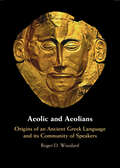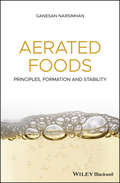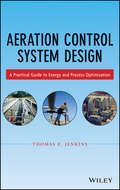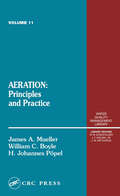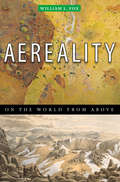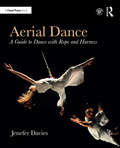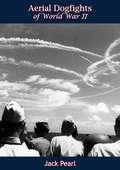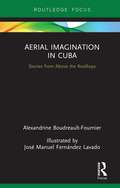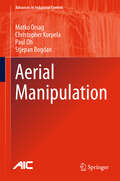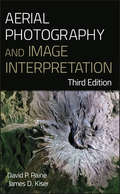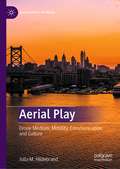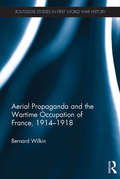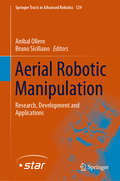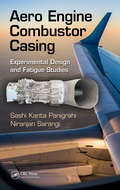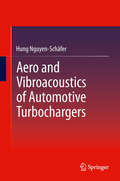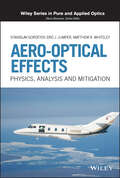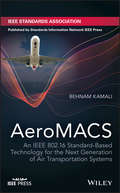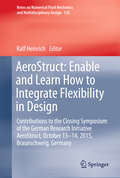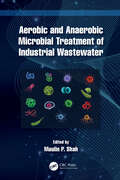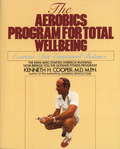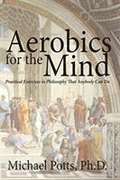- Table View
- List View
Aeolic and Aeolians: Origins of an Ancient Greek Language and its Community of Speakers
by Roger D. WoodardAeolic and Aeolians explores the origin of an ancient Greek language and the beginnings and evolution of the community of its speakers – the Aeolians. Roger Woodard argues that the starting point for both is situated in Asia Minor during the period of the Late Bronze Age, and that the ancestral Aeolic speech community can be identified with the Mycenaean peoples of Anatolia called the Ahhiyawans in Hittite records. These Bronze-Age Asian Greeks would intermarry with local Luvian peoples of western Anatolia, and the Aeolian language and identity – an identity encoded in myth-emerged from the intermixing of the two societies. Aeolian myths are central to Woodard's ground-breaking investigations presented in this volume. He demonstrates how assemblages of mythic components, what Lévi-Strauss called bricolage, enabled early Aeolians to give intellectual expression to their distinctive Greek identity. With the collapse of Bronze-Age societies in Mycenaean Greece, some of the early Aeolians of Anatolia would migrate to Europe, introducing their language and myths into Hellas.
Aerated Foods: Principles, Formation and Stability
by Ganesan NarsimhanExplore the roles aeration can play in the production, stability, and consumer experience of foods Aeration is an increasingly prevalent part of food manufacturing, bringing a light texture, enhanced appearance, and richer flavors to a wide range of products. Essential to the creation of everything from ice cream and popcorn to cheese and beer, the incorporation of fine air bubbles into the foods we consume can also boost satiety and thus reduce calorific intake. Aerated Foods examines this process in detail, offering a complete overview of all aspects of aeration. With sections that address the effects of aeration upon product structure and stability, this informative book explains how food formulation influences the shelf life, texture, and overall experience of different foods. Chapters also outline the various methods by which aeration can be achieved, breaking down the science and technology involved in the incorporation of air Details the mechanisms and overall results of aeration as a method of food processing Covers innovative and experimental aeration techniques Looks at the role of aeration in baking Aerated Foods provides food scientists, researchers, and product developers with an invaluable guide to this multifaceted and fast-growing method of food production.
Aeration Control System Design
by Thomas E. JenkinsLearn how to design and implement successful aeration control systemsCombining principles and practices from mechanical, electrical, and environmental engineering, this book enables you to analyze, design, implement, and test automatic wastewater aeration control systems and processes. It brings together all the process requirements, mechanical equipment operations, instrumentation and controls, carefully explaining how all of these elements are integrated into successful aeration control systems. Moreover, Aeration Control System Design features a host of practical, state-of-the-technology tools for determining energy and process improvements, payback calculations, system commissioning, and more.Author Thomas E. Jenkins has three decades of hands-on experience in every phase of aeration control systems design and implementation. He presents not only the most current theory and technology, but also practical tips and techniques that can only be gained by many years of experience. Inside the book, readers will find:Full integration of process, mechanical, and electrical engineering considerationsAlternate control strategies and algorithms that provide better performance than conventional proportional-integral-derivative controlPractical considerations and analytical techniques for system evaluation and designNew feedforward control technologies and advanced process monitoring systemsThroughout the book, example problems based on field experience illustrate how the principles and techniques discussed in the book are used to create successful aeration control systems. Moreover, there are plenty of equations, charts, figures, and diagrams to support readers at every stage of the design and implementation process.In summary, Aeration Control System Design makes it possible for engineering students and professionals to design systems that meet all mechanical, electrical, and process requirements in order to ensure effective and efficient operations.
Aeration: Principles and Practice, Volume 11
by James Mueller William C. Boyle Ing. H. Johannes PopelThe immense environmental challenges facing the world now and in years to come can only be met through marshalling the talents of the best environmental engineers and scientists, and through the use of innovative, cost-effective solutions. Written by three leading aeration experts, Aeration: Principles and Practice, covers the principles and practi
Aereality: On the World from Above
by William FoxWilliam Fox's writing for the last several years has been focused on how we construct aerial views, either physically (by flying) or in our imaginations.In Aereality, he flies over earthworks in Nevada and Utah, soars through the world's largest open pit mine, and surveys Los Angeles, circumnavigating large swaths of true American urban sprawl. On the East Coast, he examines the elevated art of the Hudson River Valley and New York City. And finally, in Australia, Fox examines the history and current practice of both Euro–Australian and Aboriginal aerial views, and searches for the cognitive roots of our aerial imagination.Accompanying Fox throughout his travels is a rolling cast of enlightened fliers: geographers, museum curators, landscape photographers, anthropologists, and artists. He traverses the sky in prop planes, helicopters, and hot air balloons, all with the ultimate goal of knowing and experiencing the earth from the air.
Aerial Aftermaths: Wartime from Above
by Caren KaplanFrom the first vistas provided by flight in balloons in the eighteenth century to the most recent sensing operations performed by military drones, the history of aerial imagery has marked the transformation of how people perceived their world, better understood their past, and imagined their future. In Aerial Aftermaths Caren Kaplan traces this cultural history, showing how aerial views operate as a form of world-making tied to the times and places of war. Kaplan’s investigation of the aerial arts of war—painting, photography, and digital imaging—range from England's surveys of Scotland following the defeat of the 1746 Jacobite rebellion and early twentieth-century photographic mapping of Iraq to images taken in the immediate aftermath of 9/11. Throughout, Kaplan foregrounds aerial imagery's importance to modern visual culture and its ability to enforce colonial power, demonstrating both the destructive force and the potential for political connection that come with viewing from above.
Aerial Dance: A Guide to Dance with Rope and Harness
by Jenefer DaviesAerial Dance: A Guide to Dance with Rope and Harness provides an introduction for the beginning aerialist. It covers rigging, equipment, advice on optimal conditioning, and a step-by-step guide to technique, including anatomical references, space and time considerations, and elements of force when working with and against gravity. Specific movements and choreography are framed anatomically and together reflect the pattern and order of an aerial technique class. Challenges inherent to this type of dancing are discussed, as well as wellness instruction and methods of altering these techniques for intermediate and advanced dancing. A companion website hosts video that corresponds with the technique and phrasing in the book.
Aerial Dogfights of World War II
by Jack PearlIT WAS KILL OR BE KILLED, IN A BATTLE FOR SUPREMACY IN THE SKIES…In a sense, technical advances have written finis to the Golden Age of the aerial dogfight. Modern jets, radar sights, electronically operated triggers and missiles are eliminating the human factor.In a World War II fighter plane the dimensions of war were reduced to basics—man versus man. This was war at its more personal level, in which a pilot met the enemy in an intimate struggle for survival.Here in this unforgettable book is a fitting tribute to these aces of the past—hair-raising accounts of aerial dogfights which occurred in the great land and sea battles in Europe, Africa and the Pacific.
Aerial Geology: A High-Altitude Tour of North America’s Spectacular Volcanoes, Canyons, Glaciers, Lakes, Craters, and Peaks
by Mary Caperton Morton“Get your head into the clouds with Aerial Geology.” —The New York Times Book ReviewAerial Geology is an up-in-the-sky exploration of North America’s 100 most spectacular geological formations. Crisscrossing the continent from the Aleutian Islands in Alaska to the Great Salt Lake in Utah and to the Chicxulub Crater in Mexico, Mary Caperton Morton brings you on a fantastic tour, sharing aerial and satellite photography, explanations on how each site was formed, and details on what makes each landform noteworthy. Maps and diagrams help illustrate the geological processes and clarify scientific concepts. Fact-filled, curious, and way more fun than the geology you remember from grade school, Aerial Geology is a must-have for the insatiably curious, armchair geologists, million-mile travelers, and anyone who has stared out the window of a plane and wondered what was below.
Aerial Imagination in Cuba: Stories from Above the Rooftops (Routledge Focus on Anthropology)
by Alexandrine Boudreault-FournierAerial Imagination in Cuba is a visual, ethnographic, sensorial, and poetic engagement with how Cubans imagine the sky as a medium that allows things to circulate. What do wi-fi antennas, cactuses, pigeons, lottery, and congas have in common? This book offers a series of illustrated ethno-fictional stories to explore various practices and beliefs that have seemingly nothing in common. But if you look at the sky, there is more than meets the eye. By discussing the natural, religious, and human-made visible and invisible aerial infrastructures—or systems of circulation—through short illustrated vignettes, Aerial Imagination in Cuba offers a highly creative way to explore the aerial space in Santiago de Cuba today.
Aerial Manipulation (Advances in Industrial Control)
by Matko Orsag Christopher Korpela Paul Oh Stjepan BogdanThis text is a thorough treatment of the rapidly growing area of aerial manipulation. It details all the design steps required for the modeling and control of unmanned aerial vehicles (UAV) equipped with robotic manipulators. Starting with the physical basics of rigid-body kinematics, the book gives an in-depth presentation of local and global coordinates, together with the representation of orientation and motion in fixed- and moving-coordinate systems. Coverage of the kinematics and dynamics of unmanned aerial vehicles is developed in a succession of popular UAV configurations for multirotor systems. Such an arrangement, supported by frequent examples and end-of-chapter exercises, leads the reader from simple to more complex UAV configurations. Propulsion-system aerodynamics, essential in UAV design, is analyzed through blade-element and momentum theories, analysis which is followed by a description of drag and ground-aerodynamic effects. The central part of the book is dedicated to aerial-manipulator kinematics, dynamics, and control. Based on foundations laid in the opening chapters, this portion of the book is a structured presentation of Newton-Euler dynamic modeling that results in forward and backward equations in both fixed- and moving-coordinate systems. The Lagrange-Euler approach is applied to expand the model further, providing formalisms to model the variable moment of inertia later used to analyze the dynamics of aerial manipulators in contact with the environment. Using knowledge from sensor data, insights are presented into the ways in which linear, robust, and adaptive control techniques can be applied in aerial manipulation so as to tackle the real-world problems faced by scholars and engineers in the design and implementation of aerial robotics systems. The book is completed by path and trajectory planning with vision-based examples for tracking and manipulation.
Aerial Photography and Image Interpretation
by James D. Kiser David P. PaineThe new, completely updated edition of the aerial photography classicExtensively revised to address today's technological advances, Aerial Photography and Image Interpretation, Third Edition offers a thorough survey of the technology, techniques, processes, and methods used to create and interpret aerial photographs. The new edition also covers other forms of remote sensing with topics that include the most current information on orthophotography (including digital), soft copy photogrammetry, digital image capture and interpretation, GPS, GIS, small format aerial photography, statistical analysis and thematic mapping errors, and more. A basic introduction is also given to nonphotographic and space-based imaging platforms and sensors, including Landsat, lidar, thermal, and multispectral. This new Third Edition features:Additional coverage of the specialized camera equipment used in aerial photographyA strong focus on aerial photography and image interpretation, allowing for a much more thorough presentation of the techniques, processes, and methods than is possible in the broader remote sensing texts currently availableStraightforward, user-friendly writing styleExpanded coverage of digital photographyTest questions and summaries for quick review at the end of each chapterWritten in a straightforward style supplemented with hundreds of photographs and illustrations, Aerial Photography and Image Interpretation, Third Edition is the most in-depth resource for undergraduate students and professionals in such fields as forestry, geography, environmental science, archaeology, resource management, surveying, civil and environmental engineering, natural resources, and agriculture.
Aerial Play: Drone Medium, Mobility, Communication, and Culture (Geographies of Media)
by Julia M. HildebrandThis book explores recreational uses of consumer drones from the lenses of media ecology, mobile communication, mobilities research, and science and technology studies. In this provocative ethnography, Julia M. Hildebrand discusses camera drones as mobile media for meaningful play. She thus widens perspectives onto the flying camera as foremost unmanned aircraft, spying tool, or dangerous toy towards a more comprehensive understanding of its potentials.How should we situate drone practices in recreational spaces? What ways of seeing, moving, and being do hobby drones open up? Across chapters about drone geography, communication, mobility, visuality, and human-machine relations, Aerial Play introduces novel frameworks for drone affordances, such as communication on the fly, disembodied mobilities, auratic vertical play, and drone-mindedness.In the mobile companionship with her own drone, Hildebrand contributes an innovative “auto-technographic” method for the self-reflective study of media and mobility. Ultimately, her grounded and aerial fieldwork illuminates new technological, mobile, visual, and social relations in everyday spaces.
Aerial Propaganda and the Wartime Occupation of France, 1914-18 (Routledge Studies in First World War History)
by Bernard WilkinAerial Propaganda and the Wartime Occupation of France, 1914-1918 explores the combined role played by the French and British Governments and Armies in creating and distributing millions of aerial newspapers and leaflets aimed at the French population trapped behind German lines. Drawing on extensive research and French, German and British primary sources, the book highlights a previously unknown aspect of psychological warfare that challenges the established interpretation that the occupied populations lived in a state of total isolation and that the Allied governments had no desire to provide them with morale support. Instead a very different picture emerges from this study, which demonstrates that aerial propaganda not only played a fundamental role in raising morale in the occupied territories but also fuelled resistance and clandestine publications. This book demonstrates that the existing historiographical portrayal of the occupied civilian as an uninformed victim must be replaced by a more nuanced interpretation.
Aerial Robotic Manipulation: Research, Development and Applications (Springer Tracts in Advanced Robotics #129)
by Anibal Ollero Bruno SicilianoAerial robotic manipulation integrates concepts and technologies coming from unmanned aerial systems and robotics manipulation. It includes not only kinematic, dynamics, aerodynamics and control but also perception, planning, design aspects, mechatronics and cooperation between several aerial robotics manipulators. All these topics are considered in this book in which the main research and development approaches in aerial robotic manipulation are presented, including the description of relevant systems. In addition of the research aspects, the book also includes the deployment of real systems both indoors and outdoors, which is a relevant characteristic of the book because most results of aerial robotic manipulation have been validated only indoor using motion tracking systems. Moreover, the book presents two relevant applications: structure assembly and inspection and maintenance, which has started to be applied in the industry. The Chapters of the book will present results of two main European Robotics Projects in aerial robotics manipulation: FP7 ARCAS and H2020 AEROARMS. FP7 ARCAS defined the basic concepts on aerial robotic manipulation, including cooperative manipulation. The H2020 AEROARMS on aerial robot with multiple arms and advanced manipulation capabilities for inspection and maintenance has two general objectives: (1) development of advanced aerial robotic manipulation methods and technologies, including manipulation with dual arms and multi-directional thrusters aerial platforms; and (2) application to the inspection and maintenance.
Aero Engine Combustor Casing: Experimental Design and Fatigue Studies
by Niranjan Sarangi Sashi Kanta PanigrahiThe book is focused on theoretical and experimental investigation aimed at detecting and selecting proper information related to the fundamental aspect of combustion casing design,performance and life evaluation parameters. A rational approach has been adopted to the analysis domain underlying the complexities of the process.
Aero and Vibroacoustics of Automotive Turbochargers
by Hung Nguyen-SchäferAero and Vibroacoustics of Automotive Turbochargers is a topic involving aspects from the working fields of thermodynamics of turbomachinery, aerodynamics, rotordynamics, and noise propagation computation. In this broadly interdisciplinary subject, thermodynamics of turbomachinery is used to design the turbocharger and to determine its operating conditions. Aerodynamics is needed to study the compressor flow dynamics and flow instabilities of rotating stall and surge, which can produce growling and whining-type noises. Rotordynamics is necessary to study rotor unbalance and self-excited oil-whirl instabilities, which lead to whistling and constant tone-type noises in rotating floating oil-film type bearings. For the special case of turbochargers using ball bearings, some high-order harmonic and wear noises also manifest in the rotor operating range. Lastly, noise propagation computation, based on Lighthill's analogy, is required to investigate airborne noises produced by turbochargers in passenger vehicles. The content of this book is intended for advanced undergraduates, graduates in mechanical engineering, research scientists and practicing engineers who want to better understand the interactions between these working fields and the resulting impact on the interesting topic of Aero and Vibroacoustics of Automotive Turbochargers.
Aero-Neurosis: Pilots of the First World War and the Psychological Legacies of Combat
by Mark C. Wilkins&“Lays bare the grim reality of life on a frontline squadron . . . the comprehensive physical, emotional, and mental decline these aviators endured.&” —Donna&’s Book Blog The young men who flew and fought during the First World War had no idea what was awaiting them. The &“technology shock&” that coalesced at the Western Front was not envisaged by any of the leadership or medical establishment. Despite the attendant horrors many men experienced, some felt that the dynamic context of aerial combat was something that, after the war, they still longed for . . . Doctors argued over best practice for treatment. Of course, the military wanted these men to return to duty as quickly as possible; with mounting casualties, each country needed every man. Aviation psychiatry arose as a new subset of the field, attempting to treat psychological symptoms previously unseen in combatants. The unique conditions of combat flying produced a whole new type of neurosis. Terms such as &“Aero-neurosis&” were coined to provide the necessary label yet, like shell shock, they were inadequate when it came to describing the full and complete shock to the psyche. Mark C. Wilkins finds the psychology undergirding historical events fascinating and of chief interest to him as an historian. He has included expert medical testimony and excerpts where relevant in a fascinating book that explores the legacies of aerial combat, illustrating the ways in which pilots had to amalgamate their suffering and experiences into their postwar lives. Their attempts to do so can perhaps be seen as an extension of their heroism. &“An original and absorbing study of the psychological factors of the first air war.&” —Firetrench
Aero-Optical Effects: Physics, Analysis and Mitigation (Wiley Series in Pure and Applied Optics)
by Stanislav Gordeyev Eric J. Jumper Matthew R. WhiteleyAERO-OPTICAL EFFECTS Explore the newest techniques and technologies used to mitigate the effects of air flow over airborne laser platforms Aero-Optical Effects: Physics, Analysis and Mitigation delivers a detailed and insightful introduction to aero-optics and fully describes the current understanding of the physical causes of aero-optical effects from turbulent flows at different speeds. In addition to presenting a thorough discussion of instrumentation, data reduction, and data analysis, the authors examine various approaches to aero-optical effect mitigation using both flow control and adaptive optics approaches. The book explores the sources, characteristics, measurement approaches, and mitigation means to reduce aero-optics wavefront error. It also examines the precise measurements of aero-optical effects and the instrumentation of aero-optics. Flow control for aero-optical applications is discussed, as are approaches like passive flow control, active and hybrid flow control, and closed-loop flow control. Readers will benefit from discussions of the applications of aero-optics in relation to fields like directed energy and high-speed communications. Readers will also enjoy a wide variety of useful features and topics, including: Comprehensive discussions of both aero-effects, which include the effects that air flow has over a beam director mounted on an aircraft, and aero-optics, which include atmospheric effects that degrade the ability of an airborne laser to focus a beam A treatment of air buffeting and its effects on beam stabilization and jitter An analysis of mitigating impediments to the use of high-quality laser beams from aircraft as weapons or communications systems Adaptive optics compensation for aero-optical disturbances Perfect for researchers, engineers, and scientists involved with laser weapon and beam control systems, Aero-Optical Effects: Physics, Analysis and Mitigation will also earn a place in the libraries of principal investigators in defense contract work and independent research and development.
AeroMACS: An IEEE 802.16 Standard-Based Technology for the Next Generation of Air Transportation Systems
by Behnam KamaliThis is a pioneering textbook on the comprehensive description of AeroMACS technology. It also presents the process of developing a new technology based on an established standard, in this case IEEE802.16 standards suite. The text introduces readers to the field of airport surface communications systems and provides them with comprehensive coverage of one the key components of the Next Generation Air Transportation System (NextGen); i.e., AeroMACS. It begins with a critical review of the legacy aeronautical communications system and a discussion of the impetus behind its replacement with network-centric digital technologies. It then describes wireless mobile channel characteristics in general, and focuses on the airport surface channel over the 5GHz band. This is followed by an extensive coverage of major features of IEEE 802.16-2009 Physical Layer (PHY)and Medium Access Control (MAC) Sublayer. The text then provides a comprehensive coverage of the AeroMACS standardization process, from technology selection to network deployment. AeroMACS is then explored as a short-range high-data-throughput broadband wireless communications system, with concentration on the AeroMACS PHY layer and MAC sublayer main features, followed by making a strong case in favor of the IEEE 802.16j Amendment as the foundational standard for AeroMACS networks. AeroMACS: An IEEE 802.16 Standard-Based Technology for the Next Generation of Air Transportation Systems covers topics such as Orthogonal Frequency Division Multiple Access (OFDMA), coded OFDMA, scalable OFDMA, Adaptive Modulation-Coding (AMC), Multiple-Input Multiple-Output (MIMO) systems, Error Control Coding (ECC) and Automatic Repeat Request (ARQ) techniques, Time Division Duplexing (TDD), Inter-Application Interference (IAI), and so on. It also looks at future trends and developments of AeroMACS networks as they are deployed across the world, focusing on concepts that may be applied to improve the future capacity. In addition, this text: Discusses the challenges posed by complexities of airport radio channels as well as those pertaining to broadband transmissions Examines physical layer (PHY) and Media Access Control (MAC) sublayer protocols and signal processing techniques of AeroMACS inherited from IEEE 802.16 standard and WiMAX networks Compares AeroMACS and how it relates to IEEE 802.16 Standard-Based WiMAX AeroMACS: An IEEE 802.16 Standard-Based Technology for the Next Generation of Air Transportation Systems will appeal to engineers and technical professionals involved in the research and development of AeroMACS, technical staffers of government agencies in aviation sectors, and graduate students interested in standard-based wireless networking analysis, design, and development.
AeroStruct: Contributions to the Closing Symposium of the German Research Initiative AeroStruct, October 13–14, 2015, Braunschweig, Germany (Notes on Numerical Fluid Mechanics and Multidisciplinary Design #138)
by Ralf HeinrichThis book reports on the German research initiative AeroStruct, a three-year collaborative project between universities and the aircraft industry. It describes the development of an integrated multidisciplinary simulation environment for aircraft analysis and optimization using high-fidelity methods. This system is able to run at a high level of automatism, thus representing a step forward with respect to previous ones. Its special features are: a CAD description that is independent from the disciplines involved, an automated CFD mesh generation and an automated structure model generation including a sizing process. The book also reports on test cases by both industrial partners and DLR demonstrating the advantages of the new environment and its suitability for the industry. These results were also discussed during the AeroStruct closing Symposium, which took place on 13-14 October 2015 at the DLR in Braunschweig, Germany. The book provides expert readers with a timely report on multidisciplinary aircraft design and optimization. Thanks to a good balance between theory and practice, it is expected to address an audience of both academics and professional, and to offer them new ideas for future research and development.
AeroTech Service Group, Inc.
by Andrew Mcafee David M. UptonAeroTech Service Group uses Internet protocols and other advanced computing technologies to interconnect the IS networks of McDonnell-Douglas Aerospace with many of its customers, suppliers, and other partners. The case discusses AeroTech's product and explores options for growing the firm.
Aerobic and Anaerobic Microbial Treatment of Industrial Wastewater
by Maulin P. ShahIndustrial wastewater can contain many toxic pollutants as well as varying concentrations of organic and inorganic matter. These pollutants can be carcinogenic, mutagenic, or hardly biodegradable, which could cause serious human health risks and also affect other aquatic and terrestrial biota as well. Biological treatment techniques for industrial wastewater, including aerobic and anaerobic digestion, are known to be environmentally friendly, clean, and generally superior to other physicochemical techniques. Aerobic and Anaerobic Microbial Treatment of Industrial Wastewater presents the latest information on multiple bioremediation treatment techniques; summarizes the sources, occurrence, and removal of industrial pollutants; and suggests the most appropriate treatment options for different scenarios. Describes the biochemistry of pollutant removal by aerobic and anaerobic digestion. Highlights emerging pollutants as well as resource recovery techniques from contaminated industrial wastewater. Emphasizes the role of both conventional and innovative novel technologies in aerobic and anaerobic microbial bioremediation of pollutants originated from industrial wastewater.
Aerobics Program For Total Well-Being: Exercise, Diet , And Emotional Balance
by Kenneth H. CooperFrom the medical authority, whose previous bestsellers (Aerobics, The New Aerobics, The Aerobics Way, and Aerobics for Women) have sold more than 12 million copies, comes an exciting, new and comprehensive concept for total fitness. . . . Millions have benefited from Dr. Cooper&’s famous aerobic exercise programs. He has revolutionized the way Americans get in shape and stay in shape. Now, he presents a complete program for total well-being—physically, nutritionally, emotionally. Discover for yourself why it is the most effective, enjoyable and medically sound approach to a lifetime of energy and good health.A program designed to bring physical and emotional health and vitality to every area of your life, including: • the 7 benefits of integrated aerobic exercise, including reduced risk of heart disease• the 4 types of exercise that have been most radically re-evaluated in terms of aerobic exercise• the 3 dozen ways to stay fit, and the 4 steps to making it fun• 3 complete weeks of nutritious menus• guidelines for the 22 components of a comprehensive medical exam, so you can work with your doctor to evaluate your level of fitness• plus, the aerobics way to diminish physical and emotional stress, enhance your sex life, and more
Aerobics for the Mind: Practical Exercises in Philosophy that Anybody Can Do
by Michael PottsRemember when you were a child and incessantly asked your parents "Why?" You still had that childhood gift of wondering about everything from the simple "Why can't I touch the stove eye when it's red?" to the most profound questions people can ask "Why can't I see God if He's real?" <p> A common perception of philosophers is of the wizened old guru, sitting on a mountain top contemplating his navel; or worse, a stodgy, boring intellectual that everyone avoids at parties. But philosophy, at its best, is a joyous profession. Philosophers never stop wondering, why? They ask the most profound and universal questions: "Why am I here?" "Does life have a meaning?" "Is there a God?" "Do I have an immortal soul?" "What happens when I die?" Philosophers have the joy of re-living the wonder of a child. <p> Aerobics for the Mind: Practical Exercises in Philosophy that Anybody Can Do is a book for anyone who still has that unique, childlike sense of wonder.
